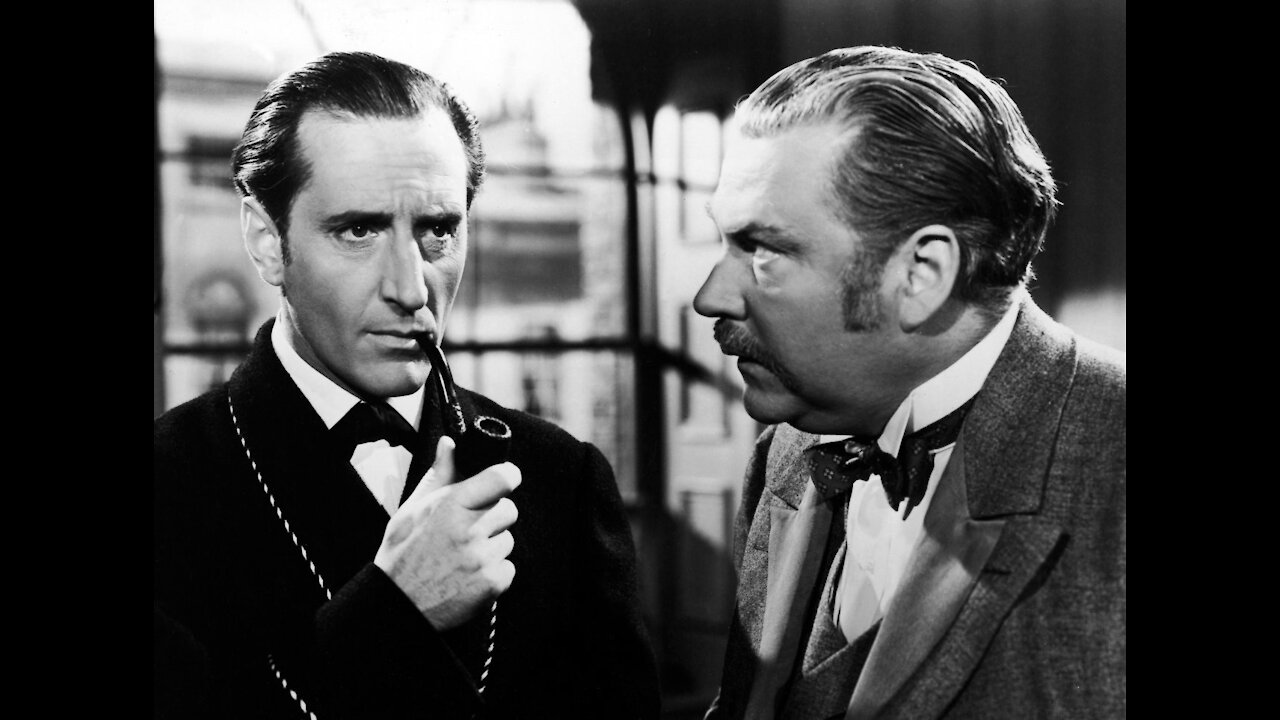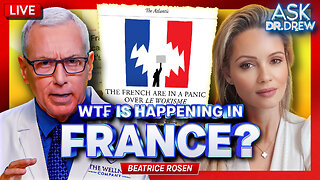Premium Only Content

Sherlock Holmes and the Secret Weapon (1943)
Sherlock Holmes (Basil Rathbone) pretends to be a Nazi spy to aid scientist Dr. Franz Tobel (William Post Jr.) and his new invention, a bombsight, in escaping a Gestapo trap in Switzerland. Holmes and Franz fly to London, where Holmes places him under the protection of his friend, Dr. Watson (Nigel Bruce). The scientist slips away against Holmes' instructions for a secret reunion with his fiancee, Charlotte Eberli (Kaaren Verne), and gives her an envelope containing a coded message. He tells Charlotte to give it to Holmes if anything should happen to him. Leaving Charlotte's apartment, an attempt to abduct him by German spies is foiled by a passing London bobby.
Tobel successfully demonstrates the bombsight for Sir Reginald Bailey (Holmes Herbert) and observers from Bomber Command. Tobel, now under the protection of Inspector Lestrade (Dennis Hoey) and Scotland Yard, tells Sir Reginald that, although willing to provide the British with his bombsight, only he will know its secret and has a complex plan for its manufacture to keep the secret safe. He separates his invention into four parts and gives one to each of four Swiss scientists, known only to him, to construct separately. Soon after, Holmes receives a call from Lestrade telling him that Tobel has disappeared. Holmes goes to Charlotte's apartment, where he receives the Tobel's envelope. Rather than the coded message, the message inside is from Holmes' nemesis, master criminal Professor Moriarty (Lionel Atwill).
Disguising himself as Ram Singh, one of Moriarty's old henchmen, Holmes searches the Soho district for information. He encounters two henchmen, but is captured by Moriarty. Holmes is put into the false bottom of a sea chest, but is rescued when Watson and Lestrade observe the henchmen struggling with its unusual weight. Holmes returns to Charlotte's apartment to search for clues to the message's contents. He finds impressions of the message left on a notepad page by immersing it in "fluorescent salts... and then photograph(ing) it by ultraviolet light." Holmes breaks the first three lines of a cunningly modified alphabet substitution code, which are the identities and locations of three of the scientists, but unable to break the fourth line, which has been altered as an added precaution, soon learns that Moriarty has murdered all three and stolen their parts. Meanwhile, Moriarty, also unable to break the fourth line, tortures Tobel for the name of the fourth scientist. Holmes deduces the change in the code and breaks the fourth line, identifying the scientist as Professor Frederick Hoffner (Henry Victor).
Moriarty accidentally deciphers the code. He sends agents to abduct Hoffner, who has the brilliance to put the four parts together should Tobel not recover from torture. The German agents bring the scientist, who is actually Holmes in disguise again, to Moriarty's seemingly undetectable stronghold. Unknown to Moriarty, Holmes had the real Hoffner attach an apparatus to their car that drips luminous paint (which Watson helped prepare) at regular intervals. Holmes uses Moriarty's vanity and pride to trick him into slowly bleeding Holmes to death "drop by drop", to stall for time. Holmes is saved at the last minute, however, by Watson and Lestrade, who with Hoffner's help, successfully followed the drops. Scotland Yard apprehends the spies, but Moriarty escapes. When he attempts to complete his escape through a secret passageway, he falls sixty feet to his death; Holmes has discovered the criminal's hidden trap door and left it open.
This is the second Basil Rathbone "Sherlock Holmes" film in which Moriarty dies. He is thrown to his death from the top of the Tower of London by Holmes in 1939's The Adventures of Sherlock Holmes. During the course of the adventure, Holmes adopts the disguises of an elderly German bookseller (taken from the Arthur Conan Doyle story The Adventure of the Empty House), the lascar sailor Ram Singh, and the Swiss scientist Professor Hoffner. His disguise as the bookseller was parodied in the film The Pink Panther. The film is a loose adaptation of The Adventure of the Dancing Men; while credited as an adaptation, the only content which bears similarity is the "dancing men" code.
-
 LIVE
LIVE
Common Threads
1 hour agoLIVE DEBATE: Is Elon Musk Going Too Far with Spending Cuts?
372 watching -
 LIVE
LIVE
Misha Petrov
36 minutes agoIllegal Immigrants Are Being Deported… and They’re OUTRAGED
169 watching -
 2:01:17
2:01:17
Revenge of the Cis
4 hours agoEpisode 1442: Conservative TM
36.1K3 -
 54:05
54:05
Game On!
6 hours ago $0.52 earned5 Biggest Super Bowl BET Mistakes You Might Be Making
13.1K2 -
 15:27
15:27
BlackDiamondGunsandGear
5 hours agoTOP 5 CCW / Whats your Favorite? #EDC
15.1K1 -
 1:02:21
1:02:21
In The Litter Box w/ Jewels & Catturd
1 day agoSCHUMER ENDORSES DOGE | In the Litter Box w/ Jewels & Catturd – Ep. 736 – 2/6/2025
77.7K43 -
 1:06:12
1:06:12
Dr. Drew
6 hours agoFrance: Woke Politics Pioneers Now REJECT Le Wokisme... WTF Changed? w/ Beatrice Rosen (The Dark Knight) – Ask Dr. Drew
56.3K4 -
 1:48:54
1:48:54
The Quartering
6 hours agoUSAID Debacle Gets WORSE, Taxpayers Funded Gamergate, Kash Patel Delayed & Mass Elon Protests!
92.5K33 -
 1:17:05
1:17:05
Right Side Broadcasting Network
8 hours agoLIVE REPLAY: President Trump Signs Executive Orders - 2/6/25
101K39 -
 LIVE
LIVE
G2G Gaming Channel
9 hours agoHelmet Day! Hope i dont need goggles too! #RumbleGaming
118 watching